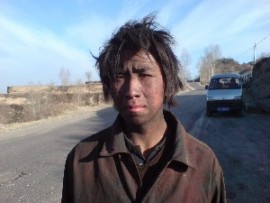Linfen, China
- Potentially Affected People: 3,000,000
- Type of Pollutants: Fly-ash, carbon monoxide, nitrogen oxides, PM-2.5, PM-10, sulfur dioxide, volatile organic compounds, arsenic, lead.
- Source of Pollution: Automobile and industrial emissions
The Problem
Shanxi Province is at the heart of China's enormous and expanding coal industry, providing about two thirds of the nation's energy. Within this highly polluted region, Linfen has been identified as one of its most polluted cities with residents claiming that they literally choke on coal dust in the evenings. In terms of air quality, the World Bank has stated that 16 out of 20 of the world's worst polluted cities are in China while the State Environmental Protection Administration (SEPA) has branded Linfen as having the worst air quality in the country. Levels of SO2 and other particulates are many times higher than limits set by the World Health Organization.
Rapid development and unequivocal faith in industry has led to the development of hundreds of unregulated coal mines, steel factories and refineries which have not only polluted indiscriminately but have also diverted agricultural water sources. Water is so tightly rationed that even the provincial capital receives water for only a few hours each day.
Health Impacts
The high levels of pollution are taking a serious toll on the health of Linfen's inhabitants. Local clinics are seeing growing cases of bronchitis, pneumonia, and lung cancer. The children of Shanxi Province also have high rates of lead poisoning. A growing number of local deaths in recent years have been linked to these overwhelming pollution levels.
Arsenicosis, a disease caused by drinking elevated concentrations of arsenic found in water is at epidemic levels in the area. Chronic exposure to this toxic chemical results in skin lesions, peripheral vascular disease, hypertension, blackfoot disease, and high cancer incidence rates. A study of Shanxi's well water published in Toxicology and Applied Pharmacology found the rate of unsafe well water in the province to be at an alarming 52%.
Status of Clean-Up Activity
By the end of this year, the city of Linfen plans to shut down 160 of 196 of its iron foundries and 57 of 153 of its coal producing plants. Small, highly polluting plants will be replaced with larger, cleaner, more regulated facilities. Emissions will be cut further by shifting from coal to gas for central heating. Last year, Linfen's residents gained 15 more days of clean, breathable air as a result of newly implemented initiatives. In addition to air quality improvement, the local government also hopes to prevent serious coal mine accidents, which at this point are the cause of more than 10 deaths annually.
Resources
China Internet Information Center. "Rivers Run Black in Shanxi Province". China Daily (2006) July 17, 2006.
http://service.china.org.cn/link/wcm/Show_Text?info_id=174874&p_qry=Linfen
Qin Jize. "Most polluted cities in China blacklisted". China Daily. (2004) July 15.
http://www.chinadaily.com.cn/english/doc/2004-07/15/content_348397.htm
"The Most Polluted City in the World: Sixteen of the 20 most polluted cities in the world are in China". The Epoch times. (2006) June 10, 2006. (refers to air pollution and particulates)
http://www.theepochtimes.com/news/6-6-10/42510.html
"Environmental quality stable in general: report". People's Daily Online (2004) July 14, 2004.
http://english.people.com.cn/200407/14/eng20040714_149521.html
http://www.theworld.org/?q=node/4059
http://environment.guardian.co.uk/waste/story/0,,2042999,00.html#article_continue
http://www.chinadaily.com.cn/china/2007-05/24/content_879724.htm
http://www.gadling.com/2007/04/01/lifen-china-boosts-tourism-with-mask-give-a-way/
Y. F. Li, Y. J. Zhang, G. L. Cao. "Distribution of seasonal SO2
emissions from fuel combustion and industrial activities in the Shanxi
province". Atmospheric Environment (Oxford, England) (Jan. '99) 33 no2
p. 257
G. Sun. "Arsenic contamination and arsenicosis in China". Toxicology and Applied Pharmacology. (2004) 198 268-271.
S-g Wang, J-l Zhang. "Blood lead levels of children in China". Environmental Sciences and Pollution Mgmt. (2004) 21(6) 355-360.
Mary Kay Magistad "Land of Pollution". The World. (2006) July 17, 2006.
Kristin Aunan, Jinghua Fang, Haakon Vennemo, Kenneth Oye, Hans M. Seip.
"Co-benefits of climate policy-lessons learned from a study in Shanxi,
China". Energy Policy. (2004) 32(4) 567-581.




